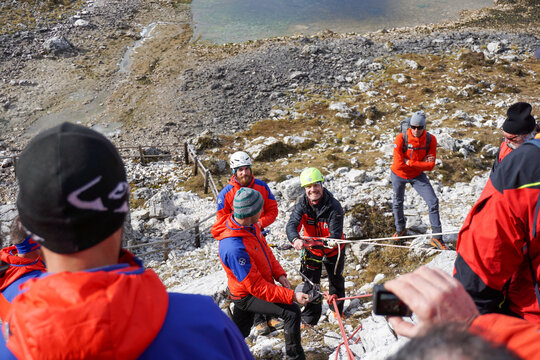Tensioned Rope Rescue Systems - TERCOM Recommendation Nr. 5

Tensioned Rope Rescue Systems
TER-REC0005 / Commission for Terrestrial Rescue
1. Introduction
When lowering or raising people with fiber ropes there is always a risk of rope failure due to sharp edges. This risk increases with increased tension on fiber ropes. ICAR recommended in 1999 to use fully redundant rope rescue systems when lowering or raising people with fiber ropes.
Despite advancements, new materials or technologies have not yet eliminated the risk of sharp edge rope failure in mountain rescue operations, so there is continuing need to manage this risk.
Research and testing (Mauthner, 2016) showed that there is a higher risk of sharp edge rope failure with a Single Loaded, Two Rope System than Two Tensioned Rope Systems. Consequently, ICAR revised this recommendation in 2017.
Since 2017, improvements to equipment and techniques demonstrate that Shared Tension Rope Systems are not limited to Two Rope Systems but can also include systems which use only one rope such as a drop loop system but can be rigged with redundancy. As such, a broader definition of this recommendation is required.
2. Recommendation
For lowering or raising people in high consequence terrain, the ICAR Terrestrial Rescue Commission recommends that teams use Tensioned Rope Rescue Systems (TRRS) that maintain tension on all ropes which connect to the rescue load.
Tensioned Rope Rescue Systems can either be a Two Tensioned Rope System or a Drop Loop System using a single rope. Additional risk assessments by rescuers are required if all tension is to be placed on one rope.
ICAR recommends redundantly rigged systems – including anchors - so that failure of any component does not result in a catastrophic outcome. A Critical Point requires an additional risk assessment. Some separation between ropes is preferred.
3. Explanatory notes
Tensioned Rope Rescue Systems are more resistant to failures from sharp edges than systems which place all the load on one strand of rope. Whenever possible, rescue teams should rig rope rescue systems with built-in redundancy when lowering or raising people with a fiber rope system.
Tensioned Rope Rescue Systems can be rigged such that ropes are capable and competent as both a load rope and a back-up rope at the same time, even with drop loop systems.
The key benefits of Tensioned Rope Rescue Systems include:
- Reduced risk of catastrophic failure from sharp edges.
- Reduced system forces.
- Reduced stopping distance due to prior rope tensioning.
- Reduced rope induced rockfall.
Testing showed no noticeable difference in risk of failure from rockfall between tensioned and un-tensioned rope systems; results were similar in all test scenarios (Mauthner, 2016).
4. Glossary
| Single Loaded Two Rope System | Full load is on one rope, no load on the second rope |
| Tensioned Rope Rescue System (TRRS) | All ropes attached to the rescue load share tension; these include TTRS and single tensioned rope systems rigged as a drop loop or a 2:1 to the load |
| High consequence terrain | conditions which can lead to serious injuries or death |
| Fiber ropes | no natural fiber ropes |
| Redundant system | A system whereby the failure of any part does not lead to catastrophic failure of the whole system |
5. References
Mauthner K. (2016), EMBC Rope Rescue NIF Equipment Testing Summary Report
| History of Revisions | |
| issued | 1999 Cingov (SK) |
| revised | 2000 Chamonix (F) |
| revised | 2005 Cortina (I) |
| revised | 2017 Soldeu (AND) |
| revised | 2025 Jackson (USA) |